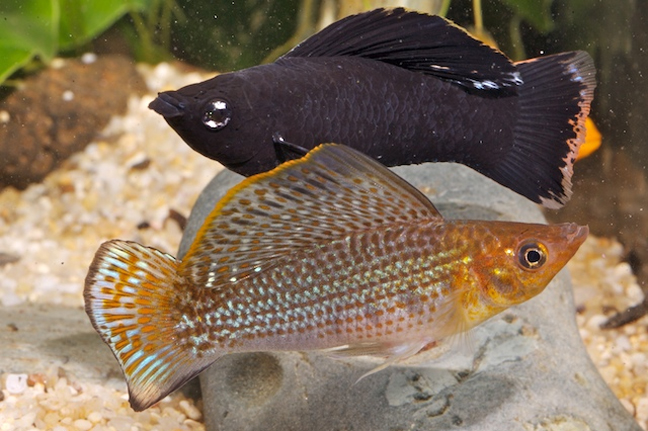Sailfin Molly, Poecilia latipinna (Lesueur 1821)

Sailfin Molly, Poecilia latipinna, male above, female below. Source: Oliver Lucanus. License: all rights reserved
Sailfin Molly, Poecilia latipinna (Lesueur 1821)
More Info
|
Distribution |
Introduced from North America, via the aquarium trade. Populations are now established in coastal drainages in southeast Queensland - in Hervey Bay, the Burrum river and the Brisbane River. Sailfin mollies have been introduced to many other parts of the world, including Hawaii, the Philippines, New Zealand, Canada, Singapore, Kenya, Columbia, The Bahamas and Puerto Rico. This tropical species prefers heavily vegetated areas in the shallow, slow-moving or still waters of marshes, ponds, dams, streams, drains, swamps and estuaries. They can tolerate wide temperature, salinity and oxygen levels. |
|
Features |
D 15-17; A 8-10; P 13. Body deep and highly compressed, arching to dorsal fin; mouth small, upturned, lower jaw a little longer than upper; eyes large; gill rakers moderately long, 24-28. Scales large; 26-28 in horizontal row; lateral line absent. Single dorsal fin positioned well forward of the anal fin origin; dorsal fin of adult males long based, tall and sail-like, but low in females; anal fin about mid-body length; tail slightly rounded to truncate. |
|
Size |
Maximum size to 15cm, commonly 6-7 cm SL. |
|
Colour |
Olive dorsally, pearly-grey with several longitudinal rows of spots on the sides and silvery-white ventrally. |
|
Feeding |
Omnivores - feed mainly on algae but also on insect larvae. |
|
Biology |
Sailfin mollies are live-bearers and are able to breed in fresh and brackish waters. Males have a gonopodium - modified anterior anal-fin rays - which is used to internally fertilise the eggs. Females produce between 30 and 300 young per brood after a four week gestation period. The young are born at a length of about 12 mm. |
|
Fisheries |
A very popular aquarium species. In Queensland, Sailfin mollies considered to be a pest species. Although they may be kept in aquaria, they cannot be used as bait (live or dead), and wild caught individuals must not be returned to the wild. |
|
Conservation |
|
|
Remarks |
Introduced to Australia in 1969 as an aquarium species. Sailfin mollies reportedly affect freshwater ecosystems by competing with native fishes for food and habitat. These live-bearers produce many large offspring and are tolerant of a wide range of environmental conditions. As a result they can survive in very degraded waterways. |
|
Similar Species |
The large dorsal fin of males is highly distinctive. Females and juveniles could be confused with mosquitofish Gambusia holbrooki but are differentiated by the position of the dorsal fin origin – behind the anal fin in Gambusia and forward of the anal fin in Poecilia latipinna. |
|
Etymology |
Poecilia, from Greek poikilos (Latinized stem poecil), meaning variegated, speckled; latipinna from Latin latus (stem lat), meaning wide, broad and pinna, meaning fin. |
|
Species Citation |
Mollienisia latipinna Lesueur, C.A. (1821). Description of a new genus, and several species of fresh water fish, indigenous to the United States. J. Acad. Nat. Sci. Philad. 2(1): 2–8 [3 pl. 3]. Lake Pontchartrain, New Orleans, Louisiana. |
|
Author |
Vanessa J. Thompson & Dianne J. Bray |
Sailfin Molly, Poecilia latipinna (Lesueur 1821)
References
Allen, G.R. (1989). Freshwater Fishes of Australia. Neptune, New Jersey : T.F.H. Publications pp. 1–240 figs
Allen, G.R., Midgley, S.H. & Allen, M. (2002). Field guide to the freshwater fishes of Australia. Perth : Western Australian Museum 394 pp. [366].
Corfield, J., Diggles, B., Jubb, C., McDowall, R. M., Moore, A., Richards, A. & Rowe, D. K. (2008). Review of the
impacts of introduced ornamental fish species that have established wild populations in Australia. Prepared for the Australian Government
Department of the Environment, Water, Heritage and the Arts.
McKay, R.J. (1984). Introductions of exotic fishes in Australia. pp. 177–199 in Courtnay, W.R. Jr & Staffer, J.R. Jr (eds) Distribution, Biology and Management of Exotic Fishes. Baltimore : John Hopkins Univ. Press
Pusey B.J., Kennard M.J. & Arthington A.H. (2004) Freshwater Fishes of North-Eastern Australia. CSIRO Publishing, Melbourne, 702 pp.
Rosen, D.E. & Bailey, R.M. (1963). The poeciliid fishes (Cyprinodontiformes), their structure, zoogeography and systematics. Bull. Am. Mus. Nat. Hist. 126(1): 1–176
Ross S.T. (ed.) (2001). The inland fishes of Mississippi. Mississippi Department of Wildlife, Fisheries, Parks. Singapore.

